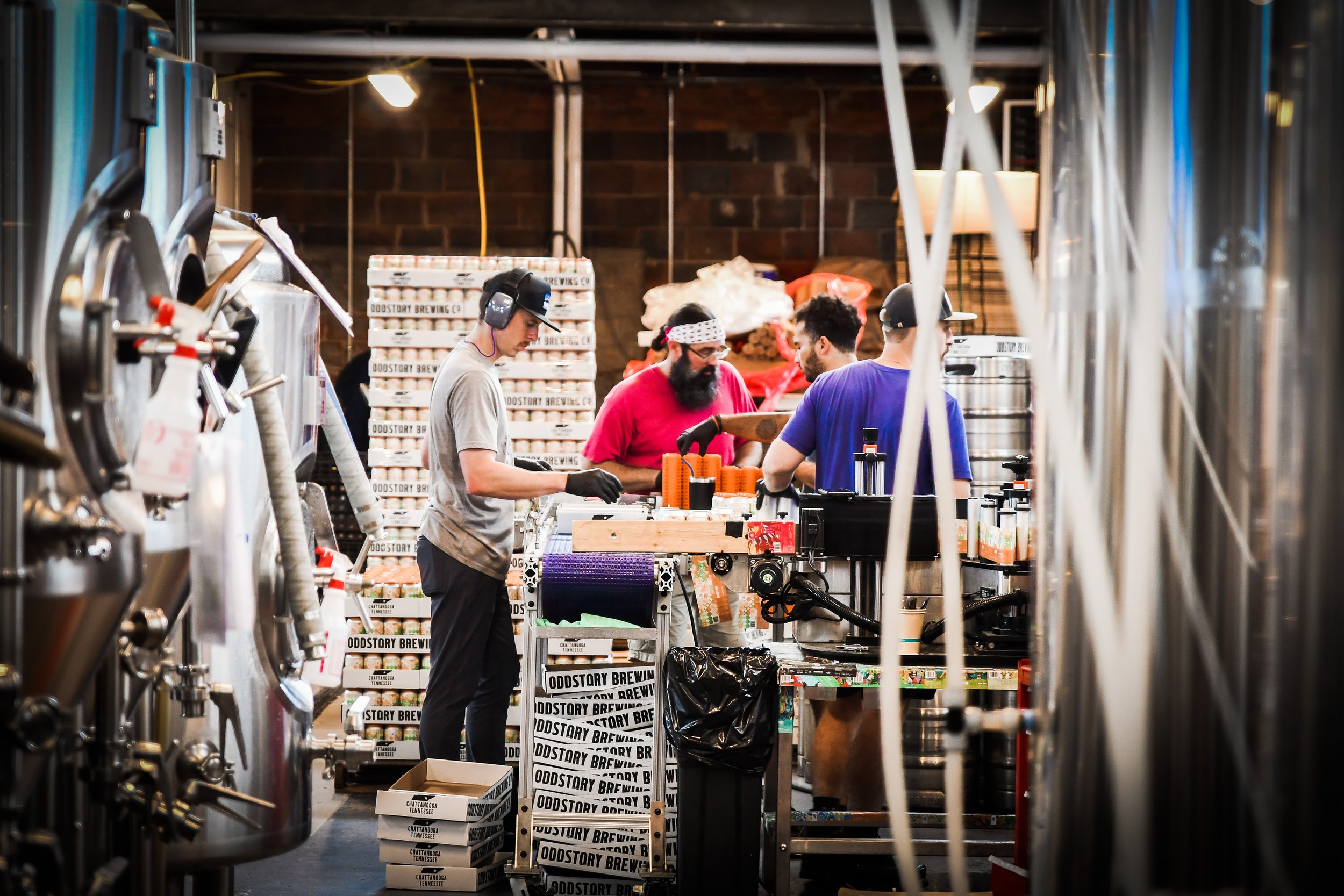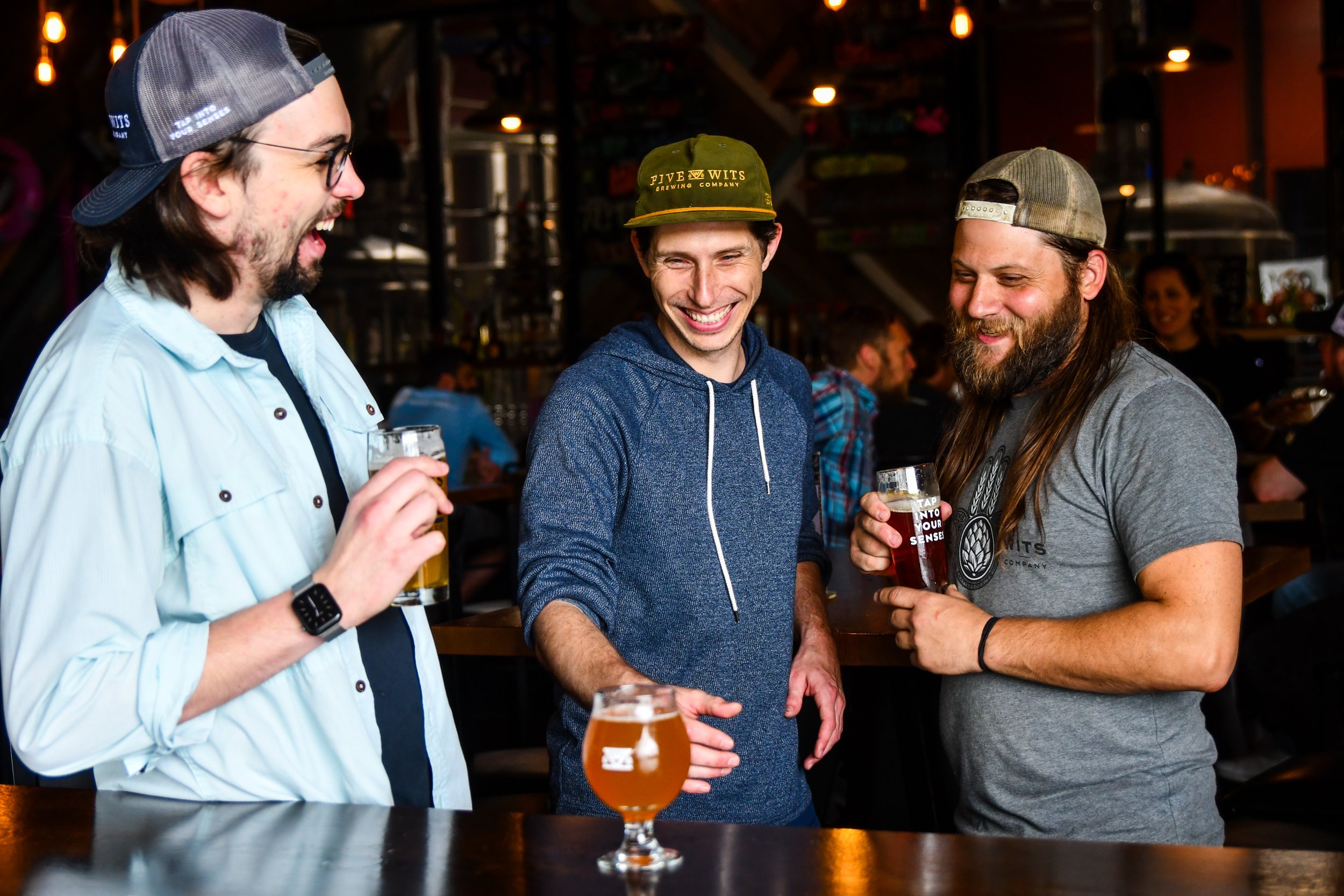I’m standing outside Chattanooga Brewing Company and it’s raining again. After long months of bare trees and uncharacteristically brutal cold snaps, the waning days of March served as a much-needed reminder of how the city’s climate can make it sometimes feel like a rainforest.
But live here long enough and you get used to it. A nicely populated taproom and accompanying live performance upstairs at the brewery serve as evidence. It takes more than a few frustrated clouds to get between a Chattanoogan and a beer.
That wasn’t always the case. Wind the clock back 30 years and there wasn’t a single craft brewery in Chattanooga. Being in the heart of moonshine country, and only two hours from Lynchburg, where Jack Daniels makes its whiskey, will do that. But as the city has grown and residents old and new started seeking new experiences from food and drink, it primed brewing for a return 90 years after the end of Prohibition.
I pull up a seat at the bar and hardly 30 seconds pass before more patrons pour in. Despite the miniature rush, it’s not long before I’m greeted by brewer Alex Keiss and a frothy glass of the brewery’s Doppelbock, Zacherl Brau. The dark beer, whose name hearkens back to a Pilsner made in the late 1800s by the previous iteration of Chattanooga Brewing Company, matches the overcast weather.
Keiss takes me on a brief tour of the brewery, showing me the various malts, grains, and tanks used to brew beer that so many locals have come to enjoy.
“It wasn’t always like this. We used to only have one or two breweries.”
“It’s been really exciting to see the growth of the craft beer industry here over the past 10 years or so,” Keiss says as he guides me past the brewing tanks. “It wasn’t always like this. We used to only have one or two breweries when I was young.”
I’ve known this for a while, but it still doesn’t seem possible. We have a state-endorsed whiskey trail. The term “moonshine” is practically synonymous with Tennessee. There were breweries in town 150 years ago. How could brewing be so “new” in Chattanooga?
Any story about craft beer in Chattanooga must begin with the Chattanooga Brewing Company. Though the current iteration only dates back to 2010, it revived a company name with more than 100 years of history.
Back in the 1890s, if you lived in Chattanooga and drank beer, you bought from the Chattanooga Brewing Company (CBC). At its peak, the operation took up a whole city block on Broad Street, the primary thoroughfare to go north and south in the city. The company even owned its own bottling plant, which was a serious investment at the time.
Even with this massive capacity, the brewery struggled to meet the appetites of Chattanoogans and the many visitors to the growing city from cities like Atlanta, Nashville, Knoxville, and Birmingham—and beyond.
Though the company was about as successful, Prohibition soon claimed its business as it did many others across the country—just as the Tennessee brewery was becoming a Southern powerhouse. In 1903, 17 years before federal Prohibition began, the state’s temperance movement passed The Adams Law, which heavily restricted the production of intoxicating beverages in Tennessee's smaller counties.
To mollify teetotalers, CBC began making “near beer” with 2% ABV or less. Though this kept the brewery afloat for some time, it went out of business in 1915 when the state banned the sale, production, and consumption of alcohol. Shortly after shutting down, the CBC’s bottling plant was bought by Coca-Cola, and Chattanooga became nationally acclaimed as the first place to bottle the world’s most popular beverage.
This fate, though not unique among southern breweries, effectively kept brewing away from Chattanooga for another 78 years.
After downing a second beer at Chattanooga Brewing Company, a rich plum Sour cheekily named “Carry on My Wayward Plum,” I take a short hop down to the brewpub Hello Monty.
Hello Monty opened in 2021 and contains a true brewery, Dynamo Brewing, within its walls. Though the name is new to most, the brothers who run the place are recognizable to any Chattanoogan who loves craft beer. Restaurateur Rob Gentry and brewer Clay Gentry, along with restaurateur Tim Hennen, are responsible for bringing craft beer back to Chattanooga. The Gentry brothers and Hennen are best known locally for founding Big River Grille, the first craft brewery in Chattanooga since the end of Prohibition. Rob and Tim opened the restaurant and brewery in 1993, and Rob soon brought on his younger brother Clay as the brewer.
Clay Gentry of Dynamo Brewing
Big River was a major step forward for brewing’s return to Chattanooga, but it took one hell of a battle to make it happen. Tennessee hadn’t spent much time making the landscape friendly toward brewers since the repeal of Prohibition. In 1993, a law still sat on the books that banned brewing in any county with under 1 million residents. Even today, there has never been a county with 1 million residents in Tennessee history, with Davidson (which includes Nashville) and Shelby (home to Memphis) counties still thousands of residents away from breaking that threshold.
In the early 1990s, there were only two craft breweries in the state of Tennessee: Boscos Restaurant & Brewing Company, in Memphis, which opened in 1991; and Bohannon Brewing Company, in Nashville, which opened in 1992. If the other two craft breweries in the state could make it work, then Rob and Tim Gentry figured they could do it, too. They got in touch with Ward Crutchfield, a powerful Democratic legislator in Hamilton County, who worked to overturn the local laws.
Big River Grille opened in September 1993, becoming the first brewery in Chattanooga since Prohibition, and only the third in the state of Tennessee. Noting Big River’s importance to the brewing community, I pay a visit to its location near the riverfront and speak with TC Sentell, the company’s current head brewer.
Draft lines at Big River Grille
The riverfront area surrounding Big River Grille bustles with dozens of restaurants, stores, bars, gift shops, hotels, and luxury apartments. And of course, there’s the Tennessee Aquarium, which holds a spot of honor on every Tennesean’s driver’s license.
“Back when this place opened, there wasn’t a lot down here,” Sentell says. “The aquarium had only opened about a year prior to Big River Grille, so everything that you see today wasn’t here.”
TC Sentell of Big River Grille
The riverfront itself, along with Lookout Mountain to the southwest, is why Chattanooga exists at all. The city began as a settlement and trading post called Ross’s Landing in 1816, and was incorporated as Chattanooga in 1839. Its convenient location along an ideal trading river encouraged rapid growth and led to the city’s development.
The district flourished for decades until Chattanooga was economically devastated by the exodus of manufacturing from the United States in the late ’70s and early ’80s. The river fell out of use as a major shipping lane in favor of other transport methods such as rail and air, leaving the riverfront to languish.
All of this made opening Big River Grille a massive gamble. It needed to overcome Tennessee’s restrictive brewing laws and attract customers in a city that people were trying to leave. But Big River stuck around.
Overcoming the barriers to craft brewing in Hamilton County is the defining legacy of Big River Grille, but the brewing arm of the company has never rested on its laurels, even after changing ownership. Sentell has the second most experience of any brewer in Chattanooga, with only Clay Gentry serving as her senior, and the pair are key in pushing the local brewing industry.
The bar and serving tanks at Dynamo Brewing
The beers at Dynamo Brewing may not immediately strike you as innovative when you read their names. Nearly all are listed as their style, no-frills executions of beers you’ve heard of before like an Hefeweizen or Mild. But Clay’s 30 years of experience as a brewer pay off in the each beer’s remarkable taste. And the setup behind the bar, which Clay also designed, certainly doesn’t hurt. Dynamo Brewing serves beer directly from horizontal serving tanks via a proof coil. The result is some of the freshest beer you can drink in Chattanooga.
“After working in the Big River Grille brewery for so long, I was excited to design something from the ground up. It was harder than I imagined it would be, but extremely rewarding.”
“After working in the Big River Grille brewery for so long, I was excited to design something from the ground up,” says Clay. “It was harder than I imagined it would be, but extremely rewarding.”
As rewarding as it is for Clay Gentry, it’s even more rewarding for the customers—and the other breweries that benefitted from Big River Grille tearing down the barriers to brewing in Chattanooga.
Chattanooga’s brewing history cleanly divides into three eras: Pre-Prohibition, Prohibition through the founding of Big River Grille, and today. These three eras largely took place in three areas: places that are gone, like the original CBC brewery; the riverfront; and Martin Luther King/Southside neighborhoods around downtown.
Brewing may have returned to Chattanooga via the riverfront, but it flourishes on the south side.
Formerly known as 9th Street or “The Big 9,” East MLK has long played a role in Chattanooga’s cultural history. For much of the 1900s, 9th Street was the center of Black culture, playing a similar role to the larger Beale Street in Memphis, Tennessee. Like Beale Street, The Big 9 was awash in blues venues, shops, restaurants, and hotels. One of the most notable locations in The Big 9 was the Martin Hotel, which at one point was known as the largest African-American hotel in the South. Today, the site where the hotel once stood is home to the Bessie Smith Cultural Center, which serves as the primary landmark on East MLK.
Nearby are Hutton & Smith Brewing Company and Oddstory Brewing Company. There are also a few bars and some legendary restaurants (Memo’s Grill and Champy’s), which are among the best places to spot local celebrities like Samuel L. Jackson.
The breweries here have taken the propitious location and run with it. Along with finding Hutton & Smith beers on-site, the company’s Promenade New England IPA, Basecamp Blonde, and others can be had at chain retail across the city at major retailers like Publix. They regularly come home from GABF with medals (most recently two bronzes and a silver), and their Tectonic Session IPA is one of my must-haves for a day at the lake.
But today I’m stopping into The Greenhouse, Oddstory’s original location, which has recently been renovated in preparation for a second location opening a few miles south. The new location aims to serve a larger clientele, most notably families, with expanded food options and a variety of games. This expansion has the added benefit of allowing The Greenhouse to experiment with new additions to their lineup like a smoked Doppelbock and Biere de Garde that don’t have the wide appeal of flagships like a Pale Ale or a Vienna Lager, but readily capture the interest of brewers and craft beer fans.
The brewery is dripped out in lush greenery, and the walls of the main room have large sliding garage doors, turning the indoor space into something more like a … well more like a greenhouse.
“We put a lot of thought into this space,” says Oddstory founder and head brewer Jay Boyd. “No one can sell your beer like you. You have to cultivate an experience that causes people to come back, beyond just the taste of the beer.”
“No one can sell your beer like you. You have to cultivate an experience that causes people to come back, beyond just the taste of the beer.”
Even the branding on the cans, designed by in-house designer Aly Butler, is colorful and free-flowing. Each one bursts with bright shapes and colors that often combine organic forms with geometric patterns. Some cans sport an art-deco look, while others boast stained glass or hints of Mesoamerican art. While each design is unique, together they visually differentiate Oddstory from other beers on the shelves of local bottle shops with their eye-catching appearance. The attention to detail has paid off. Despite it being a Tuesday, there’s a steady trickle of adventurous beer drinkers ready to try out the funky styles that are the specialty of the Greenhouse location.
This more experimental approach to opening a brewery is a hallmark of the most recent wave of craft beer in Chattanooga. With most of the laws that restricted brewing gone, brewers can spend time focusing on things like marketing and design rather than worrying about the legality of their operations.
In some ways, you need a holistic, considered approach when opening a brewery in Chattanooga today. The city has started booming again, partly thanks to COVID-19 and the increase in work-from-home options that allow people to live wherever they please while remotely punching the clock—Chattanooga boasts the fastest internet in the country thanks to EPB, the city-owned power company and internet service provider. Three people move to the city's metro area for every one person who leaves and across Tennessee, new, out-of-state residents are most often coming from California, Florida, and the Pacific Northwest, all places with unique beer cultures that can create expectations along with excitement for what might be found at Chattanooga businesses.
Ultimately, Boyd sees this all as a benefit. More people means more people to drink beer, and more people who are likely to want something new and exciting. Oddstory and its employees can’t wait to rise to the challenge.
If you walk south and slightly west of East MLK, you’ll eventually make your way to the historic Southside district. Anchored by the Chattanooga Choo Choo hotel, whose name you might recognize from the eponymous song by the Glenn Miller Orchestra, and the infamous Station Street (our quaint equivalent of Nashville’s Broadway), this district is in the process of exploding with trendy restaurants, bars, breweries, and shops. It’s my favorite place to be when I go into the city, partially because it’s just far enough from the University of Tennessee at Chattanooga campus that I’m not reminded how old I’m getting every time I want a beer.
There are about five breweries in the area, including the newly opened Tailgate, a Nashville transplant that took over the former Terminal Brewhouse space after that brewpub closed.
Today though, I’m returning to the first Chattanooga brewery I ever visited: Five Wits Brewing Company.
Founded by Elliot Kehoe, Five Wits exemplifies the potential of brewing’s future in Chattanooga. While the past eight years have been a time of explosive growth for the city’s breweries, Five Wits didn’t have it easy. The brewery opened in October 2019, four months before COVID-19 shut down virtually all public life.
The pandemic claimed most of the restaurants in the building Five Wits operates, but the brewery was able to stay in business thanks to a rapid shift to canning and to-go sales, adjustments that helped many breweries survive in 2020 and 2021. Based on its continued presence and constantly busy dining room, people liked what they bought to stick around in the years since.
“It was tough staying afloat during the lockdown,” Elliot tells me “But it worked out for the best. We turned the old dining hall space into a concert venue, and we took over some of the kitchens in order to serve food to our patrons.”
The food is a big selling point. Five Wits has the best imitation (an upgrade, really) of an In-N-Out burger that I’ve had outside of my own kitchen, and the Nashville-style hot chicken sandwich is my favorite in the city.
Though the food is integral to the business, the beer is what really shines. While its big sellers are styles most people will recognize—an IPA and a Mexican Lager—the brewery is well known among beer lovers for experimental, tropical-leaning beers. In particular, its Frieda Kettle Sour, a strawberry-pineapple-lemonade bomb that practically screams summer, has become one of the most popular options.
As one of the newest breweries in the city, Five Wits is an excellent study in both the past and future of brewing in Chattanooga. The tap board in Five Wits, which has anywhere from 14 to 20 beers at a given time, would have had more beer options than almost anywhere else in town just a decade ago. Today, there are plenty of places where you have that many beer options, and there are more breweries on the horizon.
If you step outside of Five Wits and walk to the street corner, you can see two breweries. If you walk to either of those breweries, you can see another brewery, and then another if you walk to the next. You could probably walk for three miles before you get to a spot where you can’t see a new one, which is surprising, considering downtown Chattanooga is hardly three miles across. It’s a striking signifier of how rapidly brewing has grown in the past decade.
For most of my life, Chattanooga was a beer desert. But drop by drop, with the effort of people like the Gentry brothers, that desert was thoroughly washed away and replaced with a beer scene more akin to a rainforest. We already live in a real one anyways.





















